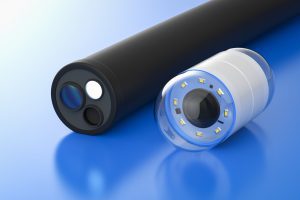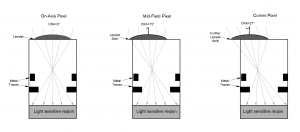In the realm of medical technology, Custom Optics Companies play an integral role in shaping innovations that push the boundaries of what is possible. Among the many facets of optical engineering, the chief ray angle stands as a paramount factor in the success of endoscopy. In this article, we’ll explore the world of endoscopy and shed light on the significance of the chief ray angle from the standpoint of Avantier.

Comprehending Endoscopy
Endoscopy is a medical technique that relies on the insertion of a specialized endoscope into the body to visualize and scrutinize internal organs and tissues. This marvel of modern medicine, consisting of a slender, flexible tube outfitted with a camera and light source, offers an invaluable minimally invasive approach to diagnosis and treatment.
The Chief Ray Angle: Unveiling its Significance
From the perspective of a Custom Optics Company, the chief ray angle in endoscopy refers to the angle at which light rays enter and exit the optical system within the endoscope. This seemingly technical parameter carries profound implications for the quality of images captured by the endoscope’s camera. In essence, the chief ray angle profoundly influences the clarity, precision, and effectiveness of the visual information relayed to medical practitioners, thereby underlining its pivotal role in the field.

The Cruciality of Chief Ray Angle
- Image Quality: In the realm of custom optics, image quality is paramount. The chief ray angle is instrumental in ensuring the superior quality of images produced by the endoscope. Precisely controlled angles of light entry and exit result in sharp, high-resolution images. Any deviation in this angle can lead to distortions, blurring, or diminished visibility of crucial details, potentially jeopardizing the accuracy of medical diagnoses.
- Patient Comfort: In the world of endoscopy, patient comfort is a top priority. Extended discomfort during procedures can lead to complications. Maintaining the correct chief ray angle minimizes the need for constant repositioning of the endoscope, reducing patient discomfort, and facilitating a smoother and more efficient examination process.
- Diagnostic Accuracy: Medical practice hinges on precision. A distorted or unclear image can hinder a healthcare provider’s ability to make an accurate diagnosis. With the appropriate chief ray angle, custom optics companies empower medical professionals to confidently identify anomalies, lesions, and other pathological conditions within the body.
- Procedural Efficiency: Endoscopic procedures can be time-consuming, and efficiency is crucial. A properly calibrated chief ray angle streamlines the procedure, allowing healthcare providers to conduct examinations more swiftly while maintaining diagnostic accuracy.
- Complication Mitigation: In certain situations, incorrect chief ray angles can result in complications during endoscopic procedures, including perforation or bleeding. Ensuring the right chief ray angle minimizes the risk of such adverse events, thereby enhancing patient safety.
Factors Influencing Chief Ray Angle
Avantier understands that various factors can impact the chief ray angle in endoscopy:
- Endoscope Design: The design of the endoscope, including the arrangement and curvature of its optical components, profoundly influences the chief ray angle. Custom optics companies meticulously engineer endoscopes to achieve optimal imaging conditions.
- Flexibility: Flexible endoscopes, in particular, must maintain a consistent chief ray angle as they traverse complex anatomical pathways. Achieving this stability necessitates advanced engineering and materials.
- Light Source: The choice and quality of the light source used in the endoscope can affect the chief ray angle. Opting for LED and fiber optic light sources, renowned for their reliability and capacity to maintain the desired angle, is a common practice.
- Camera Technology: The realm of custom optics extends to camera technology. High-resolution cameras equipped with advanced image processing capabilities are instrumental in elevating image quality, even under challenging chief ray angles.
- Physician Proficiency: The skill and experience of the physician performing the endoscopy are equally pivotal. A skilled operator adeptly manages the positioning and movement of the endoscope, ensuring the preservation of the desired chief ray angle.
Conclusion
Our mission revolves around contributing to advancements in medical technology. The world of endoscopy, made possible through innovative custom optics, has revolutionized healthcare by offering unparalleled insights into the inner workings of the human body.
In an ever-evolving landscape of technology and science, we recognize that the chief ray angle will continue to play an indispensable role in shaping the future of endoscopy. As we explore new horizons in optical engineering, our commitment remains unwavering: to enhance healthcare outcomes, promote patient well-being, and drive forward the remarkable fusion of technology and medicine that defines our era. Please contact us if you’d like to schedule a consultation or request for quote on your next project.
Related Content
GREAT ARTICLE!
Share this article to gain insights from your connections!

